|
|
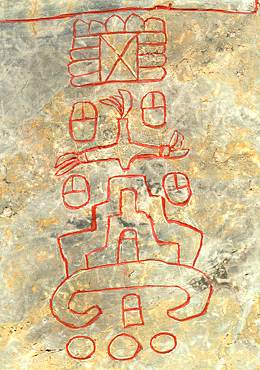
|
The incised signs on this tablet (detail) are read from top to bottom and illustrate the cosmic order of the world; the greenstone of the plaque itself represents the primordial ocean. The symbol at the top is the mythological sky-house of the north. Below this is the world tree, here in the form of a maize plant, with four seeds marking the cardinal directions. Below the maize plant appears an incurving earth sign with a stepped mountain.
Tablet With Incised Inscription |
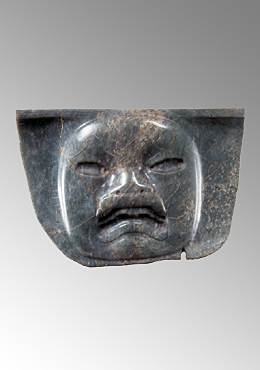
|
The majority of heirloom objects are elite items used for adornment or rulership rituals, such as this portable sculpture, an Olmec-style plaque with a Maya hieroglyphic text on its back. The Maya treasured these objects and inscribed them with hieroglyphic texts.
Plaque With Maya Hieroglyphic Text |
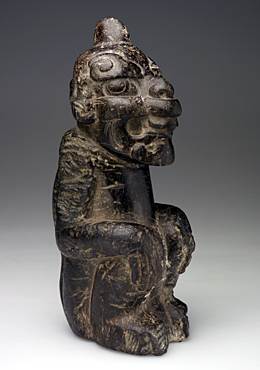
|
This anthropomorphic jaguar is carved of soft black rock. Although it looks Olmec in style, it is probably Izapan. This "were-jaguar" figure may be named in the glyphs carved on its back.
Jaguar Figure with Hieroglyphic Text |

|
The appearance of longer texts coincides with the consolidation of the office of divine kingship, and most of these longer texts focus on accession to office. This flanged pectoral (detail), once worn by an Omec ruler, later came into the possession of a Maya king. The text on its back describes a Maya lord's seating in office.
Flanged Pectoral with Maya Hieroglyphic Text. |
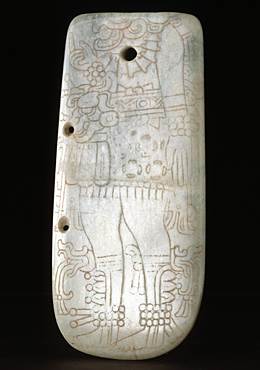
|
Jadeite plaques like this fragment were originally part of the belt assemblages worn by rulers. They were often incised with the king's portrait and a hieroglyphic text. During Maya dynastic upheavals, the victors may have demonstrated their power by dispersing the symbols of divine kingship such as these three plaques, which were transported to Costa Rica sometime between AD 350 and 600.
Belt Plaque Fragment |
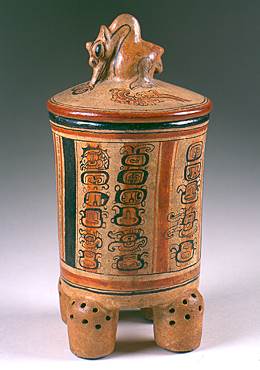
|
This lidded vessel is embellished with day names from the Maya calendar, including Imix and Ajaw, the first and last days of the 260-day ritual calendar sequence. The quality of the vessel's painting and modeling indicates the highest level of artistic production, underscoring its owner's nobility.
Lidded Vessel with Day Names |
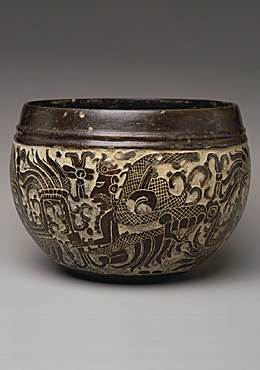
|
This carved blackware bowl is decorated with a complex tableau featuring two Vision Serpents from whose open maws emerge figures that may be the Hero Twins. This serving bowl is unusual for the Long Count date (9.2.15.4.16 1 K'ib 14 Sip, or June 1, AD 539) incised on its inside rim.
Carved Bowl with Feathered Serpents |
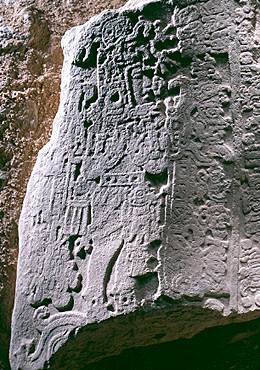
|
Stela 20 from the site of Caracol in Belize was broken into many pieces in antiquity. The fragmentary upper part of the stela was excavated in 2002. It portrays a Caracol ruler, who became king in AD 400, standing atop a sacred mountain. His portrait depicts icons associated with his divine power, including the belt with anthropomorphic and zoomorphic heads, and the jadeite belt plaques.
Stela 20 |
top home |
Copyright 2005 Los Angeles County Museum of Art